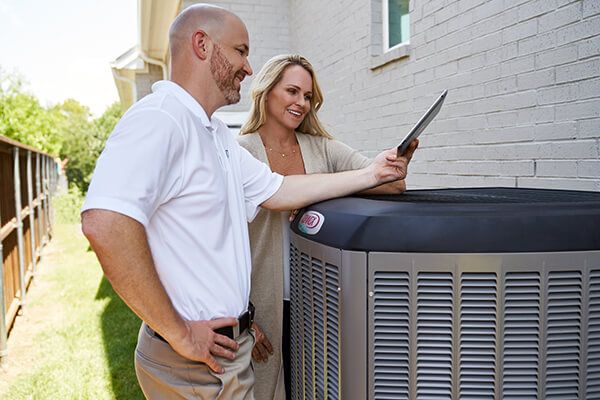
If you have a problem with your air conditioner, you can help both your HVAC tech and yourself by taking a few minutes to learn how your system works. Add to that the major components, and how to know if they are bad, and you will experience a new level of peace.
The Most Common Symptoms of Air Conditioner Problems
Your air conditioner is a relatively simple system designed to cool your space. When a part of the system doesn’t work properly, you are likely to experience some common symptoms, regardless of what part it is.
You may notice there is less air coming from your vents than there should be. Yes, this can be caused by a physical obstruction in your ductwork. However, it can also be caused by problems with many of the components in the system.
In addition to less air, you will probably notice the air is warmer than it should be with the system running. No, it does not necessarily mean you need a completely new system.
Another common symptom is increased moisture in the air. Part of the cooling process removes moisture from the air by condensing it on the evaporator coils. This is why there is a drip pan under your indoor unit.
Problems that have been brewing for a while will also manifest in climbing energy bills. Yes, there is some variance from month to month, but if you notice a trend of it constantly climbing, you have a problem.
Understanding How the System Works
Before we get into each of the components in your system, it is helpful to understand the basics of how your system works. Your system’s job is to cool the air. It accomplishes this job by circulating air and regulating refrigerant pressure.
In order for the air to cool down, it has to be drawn into the system, pass through the cooling components, and then go back into your house. Any restrictions to this process will make the entire system less effective, including clogged air filters.
To make the air cool, the system actually pulls the heat out of the air as a part of the chemical process of compressing refrigerant. When the refrigerant is pressurized, it creates a temperature shift. When that pressure drops, it becomes very cold. This change is pressure is how every refrigeration system works, including your air conditioner. If a problem exists with creating or reducing that pressure, the air cannot be cooled.
Air Conditioning Compressor
Outside your home is the condensing unit, which houses several components. The first is the compressor, which pressurizes the refrigerant. This allows it to transfer heat from inside the house to the air outside.
The compressor undergoes tremendous stress, creating the pressure needed for the refrigerant to work properly. As such, it is prone to damage and failure if other parts of the system fail.
A compressor failing will certainly create all the common symptoms previously listed. It may also be accompanied by a rattling or rumbling noise. This is caused by parts inside the compressor coming loose or breaking off.
You may also have problems with your system tripping the circuit breaker. This is caused by too much electricity being drawn because of the additional strain in the system. One of the most obvious signs of this issue is flickering lights when your air conditioner turns on.
Condensing Coil and Fan
Once the refrigerant is properly pressurized, it moves into the condensing coil. This is very much like the radiator in your car. Air moves through the coil and absorbs the intense heat from the pressurized refrigerant.
The condensing unit has a substantial fan to draw enough air through the condensing coil. After the air absorbs the heat from the condensing coil, the fan vents it out of the top of the unit.
The condensing coil is prone to getting clogged from dirt and other debris around the unit. If you start having any of the common problems, this is one of the first places to check. It is also prone to damage, which can lead to a refrigerant leak. If you have a leak, you may hear a screaming sound coming from the condensing unit.
The fan itself can also have some problems. As it runs, the blades on the fan loosen and start a rattling sound. The motor itself can burn out, especially if the system is running for longer periods because of another problem. This may lead to a rattling, screeching, or whirring sound.
Expansion Valve and Evaporator Coil
As the refrigerant movies inside, it is cooler, but is still under pressure. To make it cold enough to have the cooling effect, the pressure needs to drop significantly. The expansion valve restricts the flow of refrigerant into the evaporator coil, allowing it to expand and drop the pressure. This valve does not commonly have a lot of problems. If it does fail, it will allow too much refrigerant in, which will prevent the pressure from dropping.
After the refrigerant is restricted by the expansion valve, it flows into the evaporator coil. This is much like the condensing coil, but it is a low-pressure coil that gets very cold. Air flows through the evaporator coil, cooling it, and then it is pushed back into your home.
Your evaporator gets relatively dirty due to contaminants making their way past your air filter. To prevent an airflow restriction, it should be cleaned during seasonal maintenance. If it gets damaged, it may develop a dangerous leak. Not only will this cause possible damage to your compressor, but leaking refrigerant inside is dangerous to your health. You may hear a screaming sound coming from your indoor unit if you have a leak.
Circulating Fan
The circulating fan is what primarily controls the airflow through our system, and it is also called the blower fan. This can also collect a lot of dust and dirt, depending on how well your system is sealed. So, when the evaporator coil is cleaned, the circulating fan should be cleaned as well. It should also be tested to ensure it is properly balanced.
This particular fan runs every time any part of your heating or cooling system runs, so it may wear out more quickly than the system. It may rattle, screech, or fail to start when it is wearing out. To expend its life, repair technicians should also lubricate the motor bearings if it is not a sealed system. They should also tighten the mounting screws to reduce any extra vibration or movement while it runs.
Your system needs regular attention to keep it working properly and to ensure it reaches its intended service life. Do not worry, most of the attention is simple and keeps your repair costs down. Homeowners around Selma have trusted Beyer Air Conditioning & Heating for air conditioning repair and maintenance services for over 30 years. Our customers turn to us for indoor air quality solutions and heating installation, repair, and maintenance services as well. Call to schedule your service with our expert technicians today.



